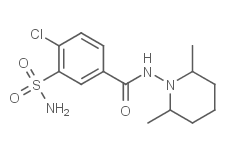
Clopamide
CAS No. 636-54-4
Clopamide( —— )
Catalog No. M17559 CAS No. 636-54-4
Clopamide is a piperidine and sulfamoylbenzamide-based diuretic with thiazide-like diuretic activity.
Purity : >98% (HPLC)
 COA
COA
 Datasheet
Datasheet
 HNMR
HNMR
 HPLC
HPLC
 MSDS
MSDS
 Handing Instructions
Handing Instructions
| Size | Price / USD | Stock | Quantity |
| 50MG | 37 | Get Quote |


|
| 100MG | 59 | Get Quote |


|
| 200MG | 85 | Get Quote |


|
| 500MG | Get Quote | Get Quote |


|
| 1G | Get Quote | Get Quote |


|
Biological Information
-
Product NameClopamide
-
NoteResearch use only, not for human use.
-
Brief DescriptionClopamide is a piperidine and sulfamoylbenzamide-based diuretic with thiazide-like diuretic activity.
-
DescriptionClopamide is a piperidine and sulfamoylbenzamide-based diuretic with thiazide-like diuretic activity.
-
In VitroClopamide is actively secreted by renal tubular cells and the True Tubular Excretion Fraction (TTEF) value is 10%.
-
In VivoThe venoconstrictor response to bradykinin is attenuated after oral administration of Clopamide (0.5 mg/kg), and by concomitant local infusion of cyclosporine-A (1-10 μg/min) in conscious dogs.
-
Synonyms——
-
PathwayOthers
-
TargetOther Targets
-
RecptorOthers
-
Research Area——
-
Indication——
Chemical Information
-
CAS Number636-54-4
-
Formula Weight345.84
-
Molecular FormulaC14H20ClN3O3S
-
Purity>98% (HPLC)
-
SolubilityIn Vitro:?DMSO : 250 mg/mL (722.88 mM)
-
SMILESC[C@@H]1CCC[C@@H](N1NC(=O)C2=CC(=C(C=C2)Cl)S(=O)(=O)N)C
-
Chemical Name——
Shipping & Storage Information
-
Storage(-20℃)
-
ShippingWith Ice Pack
-
Stability≥ 2 years
Reference
1. du Preez MJ, Lockett CJ. J Am Coll Nutr. 1991 Feb;10(1):34-7.
molnova catalog



related products
-
(S,R,S)-AHPC-PEG2-NH...
(S,R,S)-AHPC-PEG2-NH2 (VH032-PEG2-NH2) is a synthesized E3 ligase ligand-linker conjugate that incorporates the (S,R,S)-AHPC based VHL ligand and 2-unit PEG linker used in the synthesis of PROTACs.
-
Sodium gluconate
Sodium gluconate is a corrosion and scale inhibitor of ordinary steel in simulated cooling water.
-
Ethopabate
Methyl 4-acetamido-2-ethoxybenzoate is an inhibitor of folate metabolism. It is used as a coccidiostat in poultry.



 Cart
Cart
 sales@molnova.com
sales@molnova.com


